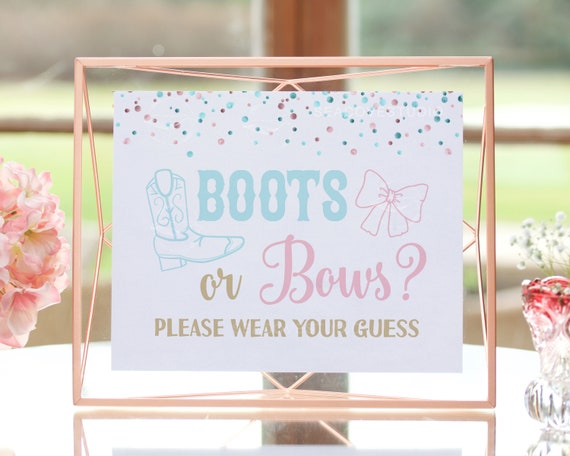In the labyrinthine pathways of cultural practices, the celebration of impending parenthood takes many forms. Among these rituals, gender reveal parties have burgeoned into a phenomenon that transcends mere celebration, transforming into a spectacle of expectation. Within this framework, the dichotomy of “Bows or Boots” emerges as a compelling metaphor for the multifaceted experiences of gender identity and societal expectations. This exploration endeavors to unravel the intricacies of these creative gender reveal ideas through the lens of cultural relativism, thereby illuminating their distinct appeal and significance.
At the heart of the “Bows or Boots” theme lies the symbolic representation of feminine and masculine identities. Bows, with their delicate curves and vibrant colors, evoke images of tradition and nostalgia; they are often aligned with societal perceptions of femininity. Conversely, boots—sturdy, rugged, and practical—conjure notions of strength and adventure often associated with masculinity. The creative juxtaposition of these elements offers a visually captivating method to disclose the gender of a forthcoming child, while simultaneously inviting participants to engage with deeper societal narratives regarding gender roles.
In a cultural context where binary gender distinctions are increasingly scrutinized, the “Bows or Boots” motif encourages an inclusive dialogue. This paradigm acknowledges that colors and categories, much like gender itself, are fluid. As cultures evolve, so too do the meanings attributed to gendered symbols. Thus, the celebration of a child’s gender may not be as straightforward as it once appeared; parents are now tasked with navigating a landscape wherein traditional ideologies must coexist with contemporary understandings of gender fluidity.
Creative gender reveal ideas inspired by the “Bows or Boots” theme can span a diverse array of activities, each tailored to resonate within different cultural frameworks. For instance, a rustic gathering in a familial backyard might feature decorations such as burlap banners and reclaimed wood accents, harmonizing with nature and evoking a sense of heritage. In this setting, parents might opt for a cake whose inner layers—tinged either pink or blue—provide a deliciously sweet surprise. Such a revelation not only satiates gourmet interests but also corporeally manifests the anticipation and joy embedded within these celebrations.
Alternatively, an outdoor adventure can facilitate an exciting twist on the traditional reveal. Picture a serene setting, perhaps a serene lakeside where family and friends gather. Here, participants can partake in a scavenger hunt, leading them to engage in playful activities while uncovering clues related to gender. At the end of the hunt, the final clue culminates in a bursting balloon filled with either blue or pink confetti. This immersive experience not only emphasizes playful engagement but also aligns with the ethos of exploration prevalent in many contemporary families, who prioritize experiential learning and communal bonding.
Furthermore, the cultural relativism perspective implores us to consider the implications of regional customs when crafting these experiences. In certain cultures, colors themselves may evoke various symbolic meanings; hence, it is essential to approach the “Bows or Boots” reveal with thoughtfulness and cultural sensitivity. For instance, in cultures where blue symbolizes beauty and tranquility, while pink represents the transient nature of life, incorporating these contextual elements into the festivities can further enrich the experience. By recognizing and respecting these nuances, individuals can create a gender reveal that resonates within their specific cultural milieu, reinforcing the larger social fabric to which the family belongs.
Moreover, involving extended family within these celebrations can enhance communal ties, affirming the essence of lineage and heritage. Grandparents, aunts, and uncles can partake in crafting the experience, whether through baking, decorating, or storytelling. This collaborative approach serves to strengthen relational bonds, fostering a shared narrative that extends beyond the individual experience and into the collective memory of the family unit. In this vein, gender reveal ceremonies become a tapestry interwoven with threads of ancestry and tradition, celebrating not merely the individual but the community as a whole.
As gender norms continue to evolve, the notion of using bows and boots as instruments of revelation reflects a shift toward embracing complexity. This celebration, steeped in cultural relativity, must resist oversimplification; it invites attendees not only to anticipate the birth of a child but to engage in broader dialogues concerning identity, expression, and societal expectations. The thoughtful integration of traditional elements with modern contexts reveals a nuanced understanding of gender that empowers individuals, invites meaningful conversation, and embraces the myriad ways in which people identify and express themselves.
In conclusion, the “Bows or Boots” gender reveal concepts serve as both a celebration of life and a critique of rigid gender binaries, showcasing how cultural practices can innovate in the face of evolving understandings. The creative ideas encapsulated within this theme offer a unique appeal that resonates with diverse audiences, inviting them to ponder the intricacies of identity and societal norms. As families continue to navigate this dynamic cultural landscape, these celebrations will undoubtedly resonate through generations, ultimately reflecting the richness of human experience.
